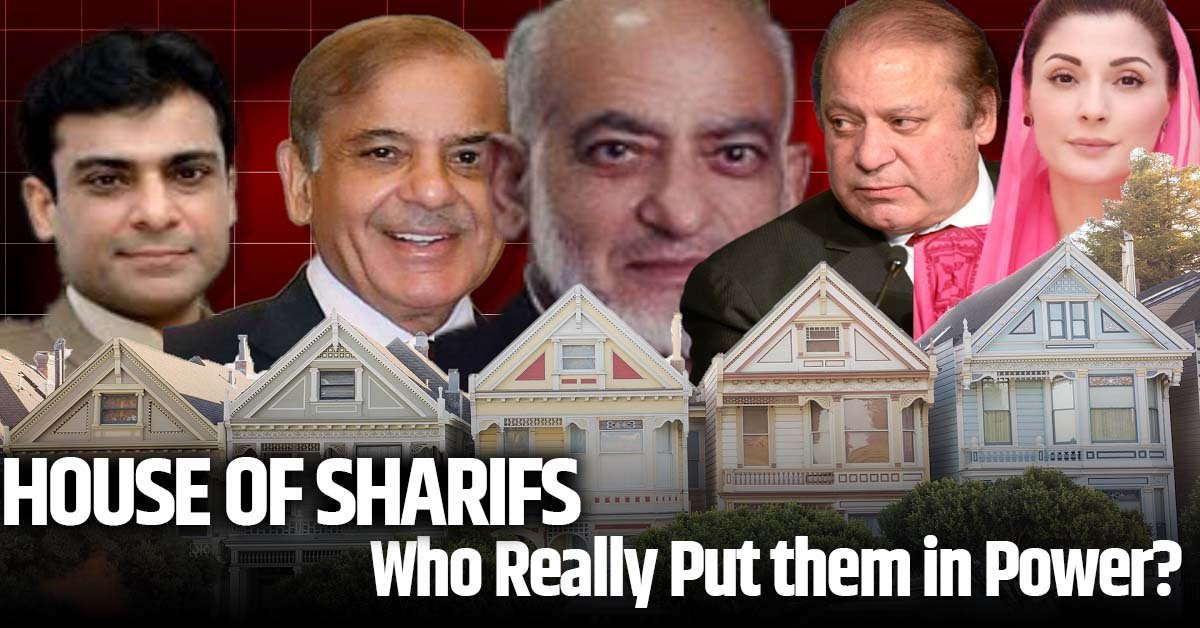History of PMLN and Nawaz Sharif
The career of Nawaz Sharif and PMLN begins something like this.
After the military martial law of 1977, the Governor of Punjab and former head of ISI, General (Retd.) Ghulam Jilani, wanted to build his personal house. However, due to the busy schedule of the governorship, he was unable to focus on the construction of his home. He assigned this responsibility to an old retired friend of his, Major Niazi, who was the secretary of Lahore’s Defence Club. Major Niazi was also occupied with his duties as secretary of the club, so he passed on this responsibility to another friend—an emerging businessman from Lahore, Mian Muhammad Sharif. Mian Muhammad Sharif happily accepted the task and began overseeing the construction of Governor Punjab General Ghulam Jilani’s house.
During this time, whenever the Governor of Punjab visited his under-construction house, he would meet Mian Sharif. Impressed by Mian Sharif’s dedication, the Governor soon developed a friendship with him—a friendship that would later not only change the political landscape of Punjab but also reshape Pakistan’s political roadmap.
In the meetings between Governor Ghulam Jilani and Mian Sharif, the Governor began interacting more with Mian Sharif’s second son, the sharp and agile Shehbaz Sharif. Shehbaz left no stone unturned in impressing Jilani.
Later, when General Zia-ul-Haq introduced civilian leaders under the umbrella of his martial law, Mian Sharif—through his service and connection with Governor Jilani—managed to secure a place for his son in Zia’s civilian cabinet.
You might be surprised to know that the first selection for the cabinet was not Mian Sharif’s eldest son, Nawaz Sharif, but his second son, Shehbaz. This incident is delightfully narrated by Hassan Abbas in his book Pakistan’s Drift into Extremism.
One evening in 1978, Mian Muhammad Sharif received an official letter stating that his son had been appointed as Punjab’s Finance Minister. Overjoyed, Mian Sharif could hardly contain his excitement. But as soon as he opened and read the letter, he saw that it carried the name of his second son, Mian Shehbaz Sharif. Distressed, Mian Sharif thought, “Shehbaz is the one whose God-given abilities are running the family business. If he joins the national cabinet, who will manage the family’s affairs?”
Immediately, Mian Sharif rushed to the Governor of Punjab, General Ghulam Jilani, and pleaded, “General Sahib, a mistake has been made! When I spoke to you about my son’s appointment, I was referring to my elder son, Mian Muhammad Nawaz Sharif—a bright and talented young man handling public relations at our factory. Please, kindly let the wheel of fortune turn in favor of my eldest son, Nawaz.”
At that time, Mian Nawaz Sharif was working as a public relations officer at his steel mill.
Acknowledging Mian Sharif’s concern, General Jilani made some adjustments and issued a new appointment letter in the name of Mian Nawaz Sharif. And thus, Muhammad Nawaz Sharif entered Pakistani politics, ready to play a long innings. He went from being a PR officer at his steel mill to directly becoming the Finance Minister of Pakistan’s largest province, Punjab. Later, he would rise to become the Chief Minister of Punjab and even serve as Pakistan’s Prime Minister three times—though never completing a full term.
And so, Nawaz Sharif’s political career began.
Who Was Nawaz Sharif’s Family? Why Did the Sharif Family Enter Politics? And How Did the Family Become the “House of Sharif”? What Have Been the Political Ups and Downs of the House of Sharif?
Let’s Talk About It.
Sharif Familiy’s Origin
The Sharif family, which has left a deep mark on Pakistan’s politics, originally belongs to a Kashmiri-Punjabi background. Before the partition of India, they lived in Jati Umra, a village located about 40 kilometers southeast of Amritsar.
Their ancestors had migrated from Kashmir centuries ago and settled there. Even today, the ancestral graveyard of the Sharif family exists in Jati Umra, Amritsar. Before partition, they were a middle-class family. During that time, Nawaz Sharif’s uncle worked in a steel furnace and later set up a small factory in Amritsar.
From Business to Industry (1947–1960s)
During the 1947 Partition, the family migrated westward from Amritsar and settled in Lahore, roughly 40 kilometers away. At the time, the family consisted of six Mian brothers, with Mian Sharif being the eldest.
By the 1960s, the Mian family had established several medium-sized factories in Lahore, including an ice factory and a water pump manufacturing unit.
In 1969, Mian Sharif and his brothers jointly set up a steel mill named Ittefaq Group Iron Foundry. Mian Sharif had three sons: Mian Nawaz Sharif, Mian Shehbaz Sharif, and Mian Abbas Sharif.
Nawaz Sharif completed his schooling at St. Anthony’s High School, commerce at Government College Lahore and later studied law at Punjab Universtiy Lahore. After his education, he began working in his father and uncles’ steel business while also developing an interest in politics. He first entered the Punjab Advisory District Council.
Early Political Leanings
It is said that during this time, Nawaz Sharif was a great admirer of the rising political leader Zulfikar Ali Bhutto and his fiery speeches. However, in the 1970s, he joined Air Marshal Asghar Khan’s party, Tehreek-e-Istiqlal, another prominent political figure of the time.
Bhutto’s Nationalization and the Sharifs’ Downfall (1972)
In 1972, under Bhutto’s government, Pakistan’s industrialists faced tough times, and the Mian brothers of Lahore were no exception. Bhutto’s nationalization policy seized private factories and industries, including the Ittefaq Foundry, placing them under government control. The family, which had just begun climbing the ladder of progress, was abruptly pushed back to square one.
At this point, Mian Sharif moved to Saudi Arabia, where he started setting up steel factories. This allowed him to sustain his business while also building strong ties with the Al-Saud royal family—a relationship that continues to this day.
Bhutto’s nationalization policy turned the Mian brothers into his staunch opponents. Mian Sharif realized that if he wanted to expand his business in Pakistan, he needed to gain influence in politics to prevent future governments from disrupting his enterprises.
Zia-ul-Haq’s Era and Political Entry (1977–1985)
When General Zia-ul-Haq overthrew Bhutto’s government and imposed martial law, the Sharif brothers got their factories back under Zia’s privatization policies. Naturally, they became strong supporters of General Zia.
For Mian Sharif and his sons, this was the perfect opportunity to ally with Zia—Bhutto’s rival—not only to reclaim their factories but also to enter politics.
As mentioned earlier, Mian Sharif cultivated close ties with Punjab Governor General Ghulam Jilani and secured a political position for his son Nawaz Sharif (instead of Shehbaz). Initially, Nawaz became a member of the Punjab Provincial Council, and in 1981, he was appointed as the Finance Minister of Punjab—Pakistan’s largest province.
An Interesting Tale: Nawaz Sharif’s Appointment
An interesting story is told about Nawaz Sharif’s appointment. When Mian Sharif requested Governor Jilani to induct his elder son Nawaz into the Punjab cabinet, Nawaz went to meet the Governor for an “interview.”
During the meeting, General Jilani asked Nawaz:
“So, what do you do at Ittefaq Industries?”
Nawaz replied, “Sir, I handle finance.”
The Governor responded, “Alright then, we’ll make you Punjab’s Finance Minister!”
And just like that, Nawaz Sharif became Punjab’s Finance Minister.
Rise Under Zia’s Patronage
Soon, Mian Sharif and Nawaz Sharif strengthened their ties with General Zia-ul-Haq, Pakistan’s most powerful man at the time.
Ayesha Jalal, in her book The Struggle for Pakistan, writes:
“In the 1980s, the Sharif family enjoyed special favors from General Zia, which helped their steel business grow exponentially. Soon, the Sharifs became one of Pakistan’s wealthiest families.“
She further notes that Zia’s policy of “crony capitalism” (an unfair economic system favoring loyalists) allowed select businessmen to obtain government loans at minimal interest—many of which were never repaid.
The House of Sharif: Political Ascent (1985–1988)
By 1985, during the non-party elections, the Sharif family’s home in Punjab’s political landscape officially transformed into the “House of Sharif.” On the surface, Nawaz Sharif appeared to be the active politician, but in reality, his father, Mian Sharif, held the reins of power. This is perhaps why he was not only called “Aba ji” (father) within the House of Sharif but also became known as “Aba ji” among politicians.
Zia’s Strategy Against the PPP
When General Zia imposed martial law, the PPP’s loyalists (jialas) began resisting him fiercely—especially after Zulfikar Ali Bhutto’s execution, which turned public sympathy toward the PPP and against Zia.
To counter the PPP’s influence, Zia launched political fronts, including the Sharif brothers, and revived Quaid-e-Azam’s Muslim League, using patriotism and religion as key slogans.
In the 1985 non-party elections, Muhammad Khan Junejo (from Sindh) was made Prime Minister, while Nawaz Sharif became Chief Minister of Punjab for the first time. Critics called him a “parachute candidate”—a product of Zia’s patronage. Nawaz held the CM position until May 1988, during which Zia and the House of Sharif remained inseparable allies.
Zia’s Death and the 1988 Elections
In 1988, Zia dismissed Junejo’s government and announced fresh elections. This split his Pakistan Muslim League (PML) into two factions—one led by Junejo and the other by Nawaz Sharif.
Before the elections could take place, General Zia died in a plane crash. Technocrat Ghulam Ishaq Khan was made President, and political parties were ordered to prepare for elections. However, the establishment still feared Benazir Bhutto’s return.
The Birth of the IJI (Islami Jamhoori Ittehad)
To counter the PPP in the 1988 elections, multiple parties, including Jamaat-e-Islami, formed an alliance called the Islami Jamhoori Ittehad (IJI). Nawaz Sharif’s PML-N was a major stakeholder, while Ghulam Mustafa Jatoi (a former PPP leader turned caretaker PM) was made its head. Nawaz served as Secretary-General.
Shuja Nawaz, in his book Crossed Swords, writes:
“The IJI was orchestrated by ISI Chief General Hamid Gul, Army Chief General Mirza Aslam Beg, and others who feared Benazir might roll back Pakistan’s nuclear program.”
General Hamid Gull and his deputy, Brigadier Imtiaz (nicknamed ‘Brigadier Billa (cat)’ for his cat-like eyes), played key roles in expanding the IJI’s influence. Gull even shifted his office to Lahore to personally guide the House of Sharif during the elections.
Election Results & Aftermath
When results came in, the PPP won in Sindh, KP, and the Centre, but Nawaz Sharif swept Punjab decisively.
Hassan Abbas, in his book, records:
“ISI Chief General Hamid Gul famously said, ‘We may not have taken Jalalabad (Afghanistan), but we saved Punjab.’ Gull and DG Military Intelligence Major General Asad Durrani openly boasted that Nawaz Sharif was their ‘product, their symbol, their pride.’”
Benazir vs. Nawaz: A New Political War
In 1988, Benazir Bhutto became Pakistan’s first female Prime Minister. Ayesha Jalal notes that Nawaz Sharif instructed his MNAs to mock Benazir’s gender by singing the Punjabi war taunt:
“Jang nahi khed zananiyaan di“
(“War is no game for women”).
Ironically, 30 years later, Nawaz Sharif would bring his own daughter, Maryam Nawaz, into politics—the same field where he once opposed a woman’s leadership. By 2024, Maryam even became Punjab’s first female Chief Minister.
Read Part 2 of PMLN political journey
In the next episode, we’ll cover:
Nawaz Sharif’s 1990 election victory and first term as Prime Minister.
His offer of a BMW car to an Army Chief (who refused it).
The power struggles of the 1990s and how the House of Sharif survived political turmoil.
Stay tuned for more gripping political history!
Sources:
1. Hassan Abbas, Pakistan’s Drift into Extremism.
2. Ayesha Jalal, The Struggle for Pakistan
3. Shuja Nawaz, Crossed Swords: Pakistan, its Army, and the Wars Within
4. Rosita Armytage, Big Capital in an Unequal World


4 thoughts on “The Untold History: How ISI and General Zia Created PMLN’s Nawaz Sharif (1970s-1988) Part-1”